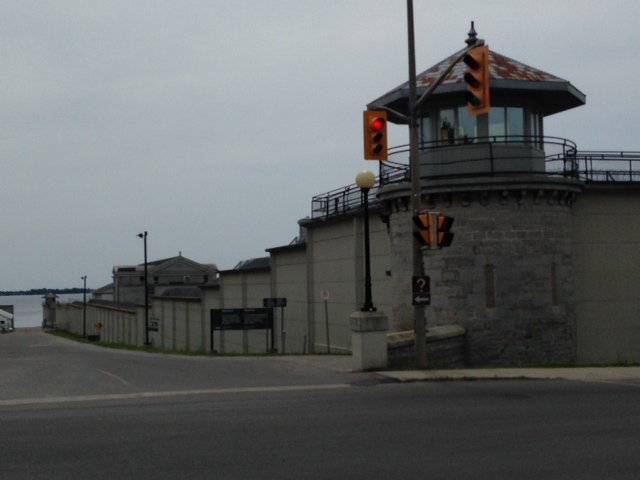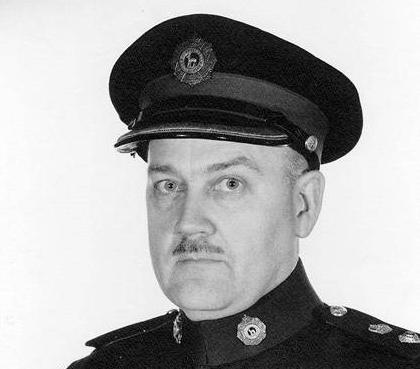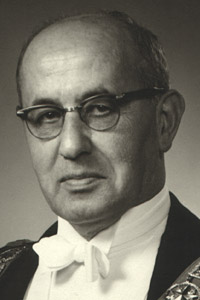Before there was a double drug-related murder
(of the MacLauchlans) in 1966 in New Westminster, there was what might be
termed a quadruple drug bust in December 1965.
As Ken and I
have related previously, when 72 year old Dr Robert Henry MacLauchlan was
arrested for drug trafficking on Wednesday, December 22, 1965, three other
people were also arrested – Margaret Ann “Nan” Cunningham, 50 (with whom he
lived at 912 Fifth Street in New Westminster), Joe Sperling, 45 and Thelma
Mosier, 40. Mosier has always struck us as being particularly mysterious;
unlike Sperling and the doctor, she had no criminal history, and we have
searched far and wide for some previous mention of her on the Internet and
elsewhere. We have often wondered how she had adapted to life and a seven year
sentence in Ontario’s Kingston Penitentiary following her transfer from
Oakalla.
Ken
and I discover a niece (With help from a friendly source...)
And now some
good news: In recent weeks, through the gracious assistance of Thelma Mosier’s
niece, Cheryl Freeman, we have gained a minor avalanche of new information on
Mosier. “But how did we find Cheryl Freeman?” our readers might ask. The answer
will demonstrate how, like on several other occasions, our research has recently
benefited from the multiplicity of sources that can be found on today’s Internet
– and from those who cruise the World Wide Web looking for people and things whose
stories interest them. Our discovery of Cheryl Freeman is a case in point.
Over the last
few months, Ken McIntosh and I have benefited from information sent to us by a
person who lives in British Columbia’s West
Kootenay region. About two months
ago, he sent us an email attachment containing a number of digitized newspaper
clippings, one of which related to an obituary for one Laverne Roberts, who was
described (among other accomplishments) as being a former three-time City
Councillor from Chilliwack, BC. What really caught our attention, though, was
that among Mrs. Roberts’ relatives Thelma Mosier was listed! The document of
course also listed her other relatives, including a daughter, Cheryl Freeman. Tips
like these, coming at us from the ether, are of great assistance to us for one
thing leads to another: searches through online lists such as telephone
directories cause letters to be written to names pulled from the White Pages.
Some such letters are never answered and yet the one to Cheryl Freeman was.
Mrs.
Freeman has graciously provided Ken and me with a lot of detail on her Aunt Thelma’s
early life, how she ended up in drug trafficking and the life-long effect of
her prison sentence. In her most recent letter to us she said this about
Thelma’s 1966 incarceration:
She was
so terrified going to Kingston. When she came out she was broken in spirit. She
had toughened up in order to survive and from what I understand she became a
respected person amongst the other women. I laughed that she still was able to
maintain her No Swearing mantra while inside. When I was at BCIT I used to see her
occasionally for tea but we never spoke of the past.
The quote above
refers to Cheryl’s initial assessment to us of Thelma Mosier always having
been, in her experience, a very gentle and quiet spoken person. It also occurred
to us, upon reading that assessment, that there appeared to be a good deal of
similarity to the other “female accomplice” in the MacLauchlan case – Margaret
Ann Cunningham, whose Woodlands School co-workers also described as quiet,
gentle and modest.
Thelma
Mosier – a background in Sechelt
According to
Cheryl Freeman, she and Thelma are connected in the following manner: Cheryl’s
grandmother, born Rachel Robson in 1908 in Durham, England, married and lived
with her first husband, John Albert Anderson, in Burnaby. Unhappy in her
marriage, she left him sometime during the 1940s. Taking up the life of cooking
in logging camps, Rachel moved to the Sechelt Peninsula on the BC Coast, met an
ambitious logger and sawmill owner from Halfmoon Bay, and married him. Her new
husband, Wilhelm “Bill” Kolterman, had been married before and, from that
union, he had a daughter named Thelma Kolterman, who later became Thelma Mosier.
However, before she became Mrs. Mosier, she was for a time Thelma Profit. Whatever
her last name, Thelma in the strictest sense was Cheryl Freeman’s step-aunt.
Expanding the
story of Thelma Mosier -- as it relates to the contribution of Ken McIntosh and
me to Cheryl Freeman’s knowledge of her aunt – has become quite “interactive”
one might say. When we first heard from Cheryl, the essence of her message was simply
that Thelma and her mother, Laverne Roberts, had been sisters, and that, yes,
she remembered when Thelma had been arrested and the awful feeling of shock and
dismay that had enveloped the Roberts family and her grandmother, Rachel
Kolterman:
Her arrest and circumstances took everyone by surprise. My grandmother
was so upset as was my Mom. Thelma had been abandoned by everyone in her
family.
The last
sentence in the above quote was very provocative and it automatically led to
the question of how and why had Thelma had come to such a low point in her life
where she felt she had no choice but to act as a drug courier for the
MacLauchlan heroin trafficking organization. As we have mentioned before, Ken
and I have often wondered how Thelma came to be involved in this crime.
Thelma
– an early marriage and an airman husband lost in the war
Cheryl gave us
some background. She told us that, after Thelma’s first husband, a Royal
Canadian Air Force pilot named Ben Profit had been lost in a bombing mission
over Europe in June 1944, leaving her with an infant son named Daniel, Thelma had
married a well-respected, hardworking logger and truck driver named Richard
Mosier, of Halfmoon Bay. “Dick” Mosier also had a son, Brad, from a previous
marriage.
As the decade of
the 1940s turned into that of the 1950s, it appears that Bill and Rachel “Rae”
Kolterman prospered – as did Richard and Thelma Mosier. By the late 1950s, the
Koltermans owned a mill, a combination gas station and restaurant, and a
building supply store – all located on the highway leading into Halfmoon Bay.
Politically,
Bill Kolterman was a supporter of the Liberal Party both federally and
provincially. It seems also that his daughter Thelma moved in the same circles,
which at times featured rather prestigious visitors to Halfmoon Bay. For
example, in the middle 1950s, the Sechelt local newspaper, The Coast News, related that Thelma Mosier had acted as the hostess
of a gathering to honour MP James Sinclair, the leading federal Liberal Party
warhorse on the West Coast, as he toured his riding of Vancouver North. (Alert
readers of a certain age of course will recognize Sinclair as the father of
Margaret Sinclair and grandfather of today’s current leading Liberal light,
Justin Trudeau. (Margaret Sinclair later married Pierre Trudeau, Liberal Prime
Minister during the period 1968 to 1984, with one interlude 1979 to early
1980.)
So how did Thelma
Mosier, who once hosted teas for a Liberal bigwig like James “Jimmy” Sinclair
end up falling into such a state of penury that she turned to making a fast
buck through drug smuggling? Ken and I believe that the answer to her fall from
grace may lie in the unhappy fate of her stepmother Rachel Kolterman, following
the death of her husband Bill. On February 19, 1960 Wilhelm Kolterman died,
after what the Coast News described
as “a brief illness”. In the few years preceding, the mill owner had been briefly
hospitalized at least once. One suspects a heart attack may have felled him.
Thelma’s
father – a prosperous Sechelt logger and businessman
From reports in the News in the years previous to
Kolterman’s death it appears that Kolterman and his extended family had
prospered. For example, it was reported in the July 29, 1954 issue of the newspaper
that he had taken on as partners his
son-in-law Dick Mosier, his brother-in-law Ken Anderson (Cheryl Freeman’s uncle)
and Doug Roberts (Cheryl’s father) in running a combination sawmill and
building supply business located on the highway leading to Half Moon Bay.
However it appears
that, following Kolterman’s untimely death, disaster struck -- quite possibly
in the shape of one Herman Uswell, who Rachel Kolterman had married a year or
so later. As Cheryl Freeman puts it:
She only married [Uswell] as she
needed help to run the Shell station and restaurant. Bill and she owned a shell
station which he ran, and the restaurant was her domain. It was a devastating
blow to her. She also had to sell her two house properties from what I
remember.
The “devastating blow”
referred to by Cheryl relates to some bad business dealings that Rachel’s new
husband entered into. Her grandmother’s fortunes, following her marriage to
Herman Uswell, went downhill because Uswell took out loans using her property
as collateral and ultimately bankrupted her. Uswell seems to have been somewhat
of an unreliable sort, as demonstrated by a story I found by searching through
the Coast News: On October 18, 1962 Uswell
was arrested for being drunk.
It seems to Ken and me
that Thelma’s financial problems may have been connected to those of Cheryl’s
grandmother Rachel. Contemplating a “timeline” of events and people, I come up
with the following possible sequence: 1. Rachel Uswell (formerly Rachel
Kolterman) loses her income and moves to Harrison Hot Springs in 1962; 2.
Thelma Mosier and Brad Kolterman come to Harrison Hot Springs in the same year,
perhaps because they were following Rachel; 3. By 1965 Thelma has moved to Fell
Avenue in Burnaby, where she is listed in the voting register as sharing a
house with the Bullerwells. (Cheryl has no knowledge of who the Bullerwells may
have been to Thelma.)
An
“old high school friend” “helps” Thelma out – and into prison!
In any case, it appears
that later Thelma moved to Burnaby and eventually fell into dire financial
straits. And, in a deep departure from character, she fell for a financial
invitation from an acquaintance from the past. As Cheryl Freeman puts it:
My mother had told me that an old high school friend of Thelma's had
convinced her to get involved in the drug business as she was having dire
financial difficulties. I have very fond memories of my aunt, she was very
soft-spoken, didn't stand for swearing around her, and seemed so respectable in
appearance etc.
When we [Laverne and Doug Roberts and their family] moved to Burnaby, I
saw her several times. I went to UBC then BCIT and then my mom left my Dad and
we moved back to our house in Chilliwack. (Summer 1972). [I] heard Thelma was
working in New West and just how she was having health problems over the years.
My mom, and grandmother would get phone calls from Thelma and that was
pretty much the only contact they had over the years. In 1992, my mother had a
stroke and my family moved down from the north and brought our Mom to live with
us in Nanaimo. I spoke to Thelma several times on the phone as at the time I
was caring for my grandmother and mother and kept Thelma up to date.
Ken and I have further questions
(of course!)
The reminiscences of Cheryl Freeman have been very helpful to Ken and
me, and we appreciate her contribution very much. Of course we also greatly
appreciate the contributions of the person who first brought her to
our attention. Perhaps as with any good detective story, more questions are
raised. Here are a few we can think of:
1. Who was the “old high school”
friend who introduced Thelma to the MacLauchlan organization?
2.
Is there anyone out there in
Internet-land who knows of a Thelma Kolterman that he or she may have gone to
school with – perhaps in Sechelt, perhaps elsewhere?
3.
Daniel Milton Profit was Thelma’s
son by RCAF wartime pilot Benjamin Profit. Daniel Profit was a truck driver who
died in a traffic accident in Alberta in 2003. Before moving to Alberta, he and
his wife, who was probably named Caroline, lived in Burnaby. Ken and I would be
interested in hearing from anyone who knew Daniel Milton Profit, his wife or --
assuming they exist – children.





